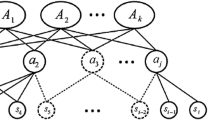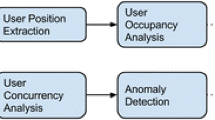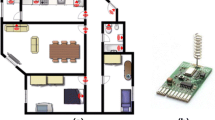Abstract
This paper presents an automated methodology for extracting the spatiotemporal activity model of a person using a wireless sensor network deployed inside a home. The sensor network is modeled as a source of spatiotemporal symbols whose output is triggered by the monitored person’s motion over space and time. Using this stream of symbols, the problem of human activity modeling is formulated as a spatiotemporal pattern-matching problem on top of the sequence of symbolic information the sensor network produces, and is solved using an exhaustive search algorithm. The effectiveness of the proposed methodology is demonstrated on a real 30-day dataset extracted from an ongoing deployment of a sensor network inside a home monitoring an elder. The developed algorithm examines the person’s data over these 30 days and automatically extracts the person’s daily pattern.







Similar content being viewed by others
Notes
The start time and duration condition parameters can be either entered directly by the user based on prior information or they can be automatically extracted from the input phoneme triplets using the methodology we presented in [15].
In practice any model building method in the literature can be used
References
Alarmnet: Assisted-living and residential monitoring network–a wireless sensor network for smart healthcare, http://www.cs.virginia.edu/wsn/medical/
Agrawal, R., Srikant, R.: Fast algorithms for mining association rules in large databases. In: VLDB ’94: Proceedings of the 20th International Conference on Very Large Data Bases, pp. 487–499. Morgan Kaufmann Publishers Inc, San Francisco, CA, USA (1994)
Agrawal, R., Srikant, R.: Mining sequential patterns. In: ICDE ’95: Proceedings of the Eleventh International Conference on Data Engineering, pp. 3–14. IEEE Computer Society, Washington, DC, USA, (1995)
Coble, J., Cook, D.J., Holder, L.B.: Structure discovery in sequentially-connected data streams. Int. J. Artif. Intel. Tools 15, 917–944 (2006)
Cook, D.J.: Health monitoring and assistance to support aging in place. J. UCS (2006)
Cook, D.J., Youngblood, G.M., Das, S.K.: A multi-agent approach to controlling a smart environment. In: Designing smart homes (2006)
Das, Sajal K., Cook, Diane J.: Designing smart environments: A paradigm based on learning and prediction. In: Proceedings of PReMI (2005)
Hasan, M., Chaoji, V., Salem, S., Parimi, N., Zaki, M.: Dmtl: a generic data mining template library. In: Workshop on Library-Centric Software Design (LCSD’05) (2005)
Heierman, E., Youngblood, M., Cook, D.J.: Mining temporal sequences to discover interesting patterns. In: KDD Workshop on mining temporal and sequential data (2004)
Intille, S.S., Larson, Kent, Tapia, E.M.: Designing and evaluating technology for independent aging in home. In: International conference on aging, disability and independence (2003)
Ivanov, Y.A., Bobick, A.F.: Recognition of visual activities and interactions by stochastic parsing. IEEE Trans. Pattern Anal. Mach. Intell. 22(8), 852–872 (2000)
Jonyer, I., Holder, L.B., Cook, D.J.: Mdl-based context-free graph grammar induction and applications. Int. J. Artif. Intel. Tools 13, 65–79 (2004)
Kossek, E.E., DeMarr, B.J., Backman, K., Kollar, M.: Assessing employees’ emerging elder care needs and reactions to dependent care benefits. Person. Manag. 22, 617–639 (1993)
Liao, L., Fox, D., Kautz, H.: Location-based activity recognition using relational markov models. In: Nineteenth International Joint Conference on Artificial Intelligence (2005)
Lymberopoulos, D., Bamis, A., Savvides, A.: Extracting temporal characteristics from sensor network data streams. Technical report TR-05-2008, Yale University (2008)
Lymberopoulos, D., Ogale, A., Savvides, A., Aloimonos, Y.: A sensory grammar for inferring behaviors in sensor networks. In: Proceedings of Information Processing in Sensor Networks (IPSN) April (2006)
Lymberopoulos, D., Teixeira, T., Savvides, A.: Detecting patterns for assisted living using sensor networks. In: Proceedings of SensorComm October (2007)
Lymberopoulos, D., Teixeira, T., Savvides, A.: Macroscopic human behavior interpretation using distributed imagers and other sensors. In: to appear in Proceedings of IEEE (2008)
Mannila, Heikki, Toivonen, Hannu, Verkamo, A. Inkeri: Discovery of frequent episodes in event sequences. Data Min. Knowl. Discov. 1(3), 259–289 (1997)
Moore, D., Essa, I.: In: Recognizing multitasked activities from video using stochastic context-free grammar, pp. 770–776. AAI, Menlo Park, CA, USA (2002)
Nayak, J.R., Cook, D.J.: Approximate association rule mining. In: Proceedings of FLAIRS Conference (2001)
Ogale, A.S., Karapurkar, A., Aloimonos, Y.: View-invariant modeling and recognition of human actions using grammars. ICCV’05 October (2005)
Park, S., Aggarwal, J.K.: In: Event Semantics in Two-person Interactions August (2004)
Patterson, D.J., Fox, D., Kautz, H., Philipose, M.: Fine-grained activity recognition by aggregating abstract object usage. In: IEEE International Symposium on Wearable Computers October (2005)
Philipose, M., Fishkin, K.P., Perkowitz, M., Patterson, D.J., Fox, D., Kautz, H., Hahnel, D.: Inferring activities from interactions with objects. IEEE Pervasive Comput. 03(4), 50–57 (2004)
Ramirez, J.C.G., Cook, D.J., Peterson, L.L., Peterson, D.M.: An event set approach to sequence discovery in medical data. Intell. Data Anal. 4, 513–530 (2000)
Romer, K.: Distributed mining of spatio-temporal event patterns in sensor networks. In: EAWMS/DCOSS (2006)
Tan, P.-N., Steinbach, M., Kumar, V.: Introduction to Data Mining. Addison-Wesley, USA (2006)
Tapia, E.M., Intille, S.S., Larson, K.: Activity recognition in the home setting using simple and ubiquitous sensors. In: PERVASIVE 2004 (2004)
van den Berg Jeths, A., Thorslund, M.: Will resources for elder care be scarce? The Hastings Center Report (1994)
Willison, K.D., Gavin, G.J., Andrews, J.: Complementary medicine and older people: past research and future directions. Comple. Therap. Nurs. Midwifery 10(2), 80–91 (2004)
Zaki, M.J., Parimi, N., De, N., Gao, F., Phoophakdee, B., Urban, J., Chaoji, V., Hasan, M. Al, Salem, S.: Towards generic pattern mining. In: International Conference on Formal Concept Analysis (2004)
Author information
Authors and Affiliations
Corresponding author
Rights and permissions
About this article
Cite this article
Lymberopoulos, D., Bamis, A. & Savvides, A. Extracting spatiotemporal human activity patterns in assisted living using a home sensor network. Univ Access Inf Soc 10, 125–138 (2011). https://doi.org/10.1007/s10209-010-0197-5
Published:
Issue Date:
DOI: https://doi.org/10.1007/s10209-010-0197-5




